Matrex v0.6.8 Matrex View Source
Performs fast operations on matrices using native C code and CBLAS library.
Access behaviour
Access behaviour is partly implemented for Matrex, so you can do:
iex> m = Matrex.magic(3)
#Matrex[3×3]
┌ ┐
│ 8.0 1.0 6.0 │
│ 3.0 5.0 7.0 │
│ 4.0 9.0 2.0 │
└ ┘
iex> m[2][3]
7.0Or even:
iex> m[1..2]
#Matrex[2×3]
┌ ┐
│ 8.0 1.0 6.0 │
│ 3.0 5.0 7.0 │
└ ┘There are also several shortcuts for getting dimensions of matrix:
iex> m[:rows]
3
iex> m[:size]
{3, 3}calculating maximum value of the whole matrix:
iex> m[:max]
9.0or just one of it's rows:
iex> m[2][:max]
7.0calculating one-based index of the maximum element for the whole matrix:
iex> m[:argmax]
8and a row:
iex> m[2][:argmax]
3Inspect protocol
Matrex implements Inspect and looks nice in your console:
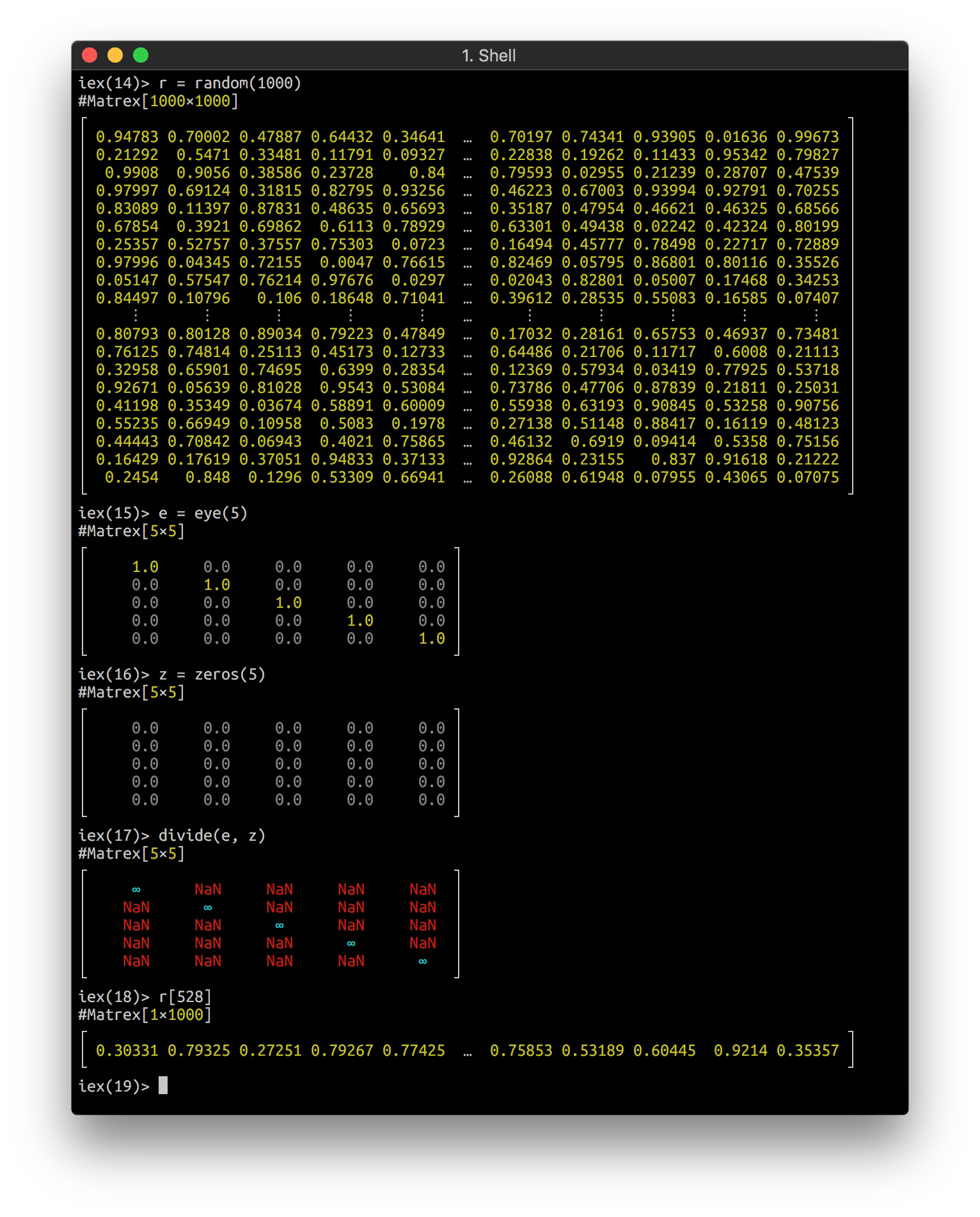
Math operators overloading
Matrex.Operators module redefines Kernel math operators (+, -, *, / <|>) and
defines some convenience functions, so you can write calculations code in more natural way.
It should be used with great caution. We suggest using it only inside specific functions
and only for increased readability, because using Matrex module functions, especially
ones which do two or more operations at one call, are 2-3 times faster.
Example
def lr_cost_fun_ops(%Matrex{} = theta, {%Matrex{} = x, %Matrex{} = y, lambda} = _params)
when is_number(lambda) do
# Turn off original operators
import Kernel, except: [-: 1, +: 2, -: 2, *: 2, /: 2, <|>: 2]
import Matrex.Operators
import Matrex
m = y[:rows]
h = sigmoid(x * theta)
l = ones(size(theta)) |> set(1, 1, 0.0)
j = (-t(y) * log(h) - t(1 - y) * log(1 - h) + lambda / 2 * t(l) * pow2(theta)) / m
grad = (t(x) * (h - y) + (theta <|> l) * lambda) / m
{scalar(j), grad}
endThe same function, coded with module methods calls (2.5 times faster):
def lr_cost_fun(%Matrex{} = theta, {%Matrex{} = x, %Matrex{} = y, lambda} = _params)
when is_number(lambda) do
m = y[:rows]
h = Matrex.dot_and_apply(x, theta, :sigmoid)
l = Matrex.ones(theta[:rows], theta[:cols]) |> Matrex.set(1, 1, 0)
regularization =
Matrex.dot_tn(l, Matrex.square(theta))
|> Matrex.scalar()
|> Kernel.*(lambda / (2 * m))
j =
y
|> Matrex.dot_tn(Matrex.apply(h, :log), -1)
|> Matrex.subtract(
Matrex.dot_tn(
Matrex.subtract(1, y),
Matrex.apply(Matrex.subtract(1, h), :log)
)
)
|> Matrex.scalar()
|> (fn
:nan -> :nan
x -> x / m + regularization
end).()
grad =
x
|> Matrex.dot_tn(Matrex.subtract(h, y))
|> Matrex.add(Matrex.multiply(theta, l), 1.0, lambda)
|> Matrex.divide(m)
{j, grad}
endEnumerable protocol
Matrex implements Enumerable, so, all kinds of Enum functions are applicable:
iex> Enum.member?(m, 2.0)
true
iex> Enum.count(m)
9
iex> Enum.sum(m)
45For functions, that exist both in Enum and in Matrex it's preferred to use Matrex
version, beacuse it's usually much, much faster. I.e., for 1 000 x 1 000 matrix Matrex.sum/1
and Matrex.to_list/1 are 438 and 41 times faster, respectively, than their Enum counterparts.
Saving and loading matrix
You can save/load matrix with native binary file format (extra fast) and CSV (slow, especially on large matrices).
Matrex CSV format is compatible with GNU Octave CSV output, so you can use it to exchange data between two systems.
Example
iex> Matrex.random(5) |> Matrex.save("rand.mtx")
:ok
iex> Matrex.load("rand.mtx")
#Matrex[5×5]
┌ ┐
│ 0.05624 0.78819 0.29995 0.25654 0.94082 │
│ 0.50225 0.22923 0.31941 0.3329 0.78058 │
│ 0.81769 0.66448 0.97414 0.08146 0.21654 │
│ 0.33411 0.59648 0.24786 0.27596 0.09082 │
│ 0.18673 0.18699 0.79753 0.08101 0.47516 │
└ ┘
iex> Matrex.magic(5) |> Matrex.divide(Matrex.eye(5)) |> Matrex.save("nan.csv")
:ok
iex> Matrex.load("nan.csv")
#Matrex[5×5]
┌ ┐
│ 16.0 ∞ ∞ ∞ ∞ │
│ ∞ 4.0 ∞ ∞ ∞ │
│ ∞ ∞ 12.0 ∞ ∞ │
│ ∞ ∞ ∞ 25.0 ∞ │
│ ∞ ∞ ∞ ∞ 8.0 │
└ ┘NaN and Infinity
Float special values, like :nan and :inf live well inside matrices,
can be loaded from and saved to files.
But when getting them into Elixir they are transferred to :nan,:inf and :neg_inf atoms,
because BEAM does not accept special values as valid floats.
iex> m = Matrex.eye(3)
#Matrex[3×3]
┌ ┐
│ 1.0 0.0 0.0 │
│ 0.0 1.0 0.0 │
│ 0.0 0.0 1.0 │
└ ┘
iex> n = Matrex.divide(m, Matrex.zeros(3))
#Matrex[3×3]
┌ ┐
│ ∞ NaN NaN │
│ NaN ∞ NaN │
│ NaN NaN ∞ │
└ ┘
iex> n[1][1]
:inf
iex> n[1][2]
:nanLink to this section Summary
Functions
Adds scalar to matrix.
Adds two matrices or scalar to each element of matrix. NIF.
Applies given function to each element of the matrix and returns the matrex of results. NIF.
Applies function to elements of two matrices and returns matrix of function results.
Returns one-based index of the biggest element. NIF.
Get element of a matrix at given one-based (row, column) position.
Matrix cholesky decompose. NIF, via naive implementation.
Get column of matrix as matrix (vector) in matrex form. One-based.
Get column of matrix as list of floats. One-based, NIF.
Concatenate list of matrices along columns.
Concatenate two matrices along rows or columns. NIF.
Checks if given element exists in the matrix.
Create new matrix with only diagonal elements from a given matrix.
Divides two matrices element-wise or matrix by scalar or scalar by matrix. NIF through find/2.
Matrix multiplication. NIF, via cblas_sgemm().
Matrix multiplication with addition of third matrix. NIF, via cblas_sgemm().
Computes dot product of two matrices, then applies math function to each element of the resulting matrix.
Matrix multiplication where the second matrix needs to be transposed. NIF, via cblas_sgemm().
Matrix dot multiplication where the first matrix needs to be transposed. NIF, via cblas_sgemm().
Create eye (identity) square matrix of given size.
Create square matrix filled with given value. Inlined.
Create matrix filled with given value. NIF.
Find position of the first occurence of the given value in the matrix. NIF.
Return first element of a matrix.
Matrix forward substitution. NIF, via naive C implementation.
Prints monochrome or color heatmap of the matrix to the console.
An alias for eye/1.
Returns list of all rows of a matrix as single-row matrices.
Returns range of rows of a matrix as list of 1-row matrices.
Load matrex from file.
Creates "magic" n*n matrix, where sums of all dimensions are equal.
Maximum element in a matrix. NIF.
Returns maximum finite element of a matrex. NIF.
Minimum element in a matrix. NIF.
Returns minimum finite element of a matrex. NIF.
Elementwise multiplication of two matrices or matrix and a scalar. NIF.
Negates each element of the matrix. NIF.
Creates new matrix from list of lists or text representation (compatible with MathLab/Octave).
Creates new matrix with values provided by the given function.
Bring all values of matrix into [0, 1] range. NIF.
Create matrex of ones of square dimensions or consuming output of size/1 function.
Create matrix filled with ones.
Prints matrix to the console.
Create square matrix of random floats.
Create matrix of random floats in [0, 1] range. NIF.
Reshapes list of values into a matrix of given size or changes the shape of existing matrix.
Resize matrix by scaling its dimenson with scale. NIF.
Get row of matrix as matrix (vector) in matrex form. One-based.
Return matrix row as list by one-based index.
Saves matrex into file.
Transfer one-element matrix to a scalar value.
Set element of matrix at the specified position (one-based) to new value.
Set column of a matrix to the values from the given 1-column matrix. NIF.
Return size of matrix as {rows, cols}
Produces element-wise squared matrix. NIF through multiply/4.
Returns submatrix for a given matrix. NIF.
Subtracts two matrices or matrix from scalar element-wise. NIF.
Subtracts the second matrix or scalar from the first. Inlined.
Sums all elements. NIF.
Convert any matrix m×n to a column matrix (m*n)×1.
Converts to flat list. NIF.
Converts to list of lists. NIF.
Convert any matrix m×n to a row matrix 1×(m*n).
Trace of matrix (sum of all diagonal elements). Elixir.
Transposes a matrix. NIF.
Updates the element at the given position in matrix with function.
Create square matrix of size size rows × size columns, filled with zeros. Inlined.
Create matrix of zeros of the specified size. NIF, using memset().
Link to this section Types
Link to this section Functions
Adds scalar to matrix.
See Matrex.add/4 for details.
Adds two matrices or scalar to each element of matrix. NIF.
Can optionally scale any of the two matrices.
C = αA + βB
Raises ErlangError if matrices' sizes do not match.
Examples
iex> Matrex.add(Matrex.new([[1,2,3],[4,5,6]]), Matrex.new([[7,8,9],[10,11,12]]))
#Matrex[2×3]
┌ ┐
│ 8.0 10.0 12.0 │
│ 14.0 16.0 18.0 │
└ ┘Adding with scalar:
iex> m = Matrex.magic(3)
#Matrex[3×3]
┌ ┐
│ 8.0 1.0 6.0 │
│ 3.0 5.0 7.0 │
│ 4.0 9.0 2.0 │
└ ┘
iex> Matrex.add(m, 1)
#Matrex[3×3]
┌ ┐
│ 9.0 2.0 7.0 │
│ 4.0 6.0 8.0 │
│ 5.0 10.0 3.0 │
└ ┘With scaling each matrix:
iex> Matrex.add(Matrex.new("1 2 3; 4 5 6"), Matrex.new("3 2 1; 6 5 4"), 2.0, 3.0)
#Matrex[2×3]
┌ ┐
│ 11.0 10.0 9.0 │
│ 26.0 25.0 24.0 │
└ ┘Applies given function to each element of the matrix and returns the matrex of results. NIF.
If second argument is an atom, then applies C language math function.
Example
iex> Matrex.magic(5) |> Matrex.apply(:sigmoid)
#Matrex[5×5]
┌ ┐
│-0.95766-0.53283 0.28366 0.7539 0.13674 │
│-0.99996-0.65364 0.96017 0.90745 0.40808 │
│-0.98999-0.83907 0.84385 0.9887-0.54773 │
│-0.91113 0.00443 0.66032 0.9912-0.41615 │
│-0.75969-0.27516 0.42418 0.5403 -0.1455 │
└ ┘The following math functions from C
:exp, :exp2, :sigmoid, :expm1, :log, :log2, :sqrt, :cbrt, :ceil, :floor, :truncate, :round,
:abs, :sin, :cos, :tan, :asin, :acos, :atan, :sinh, :cosh, :tanh, :asinh, :acosh, :atanh,
:erf, :erfc, :tgamma, :lgammIf second argument is a function that takes one argument, then this function receives the element of the matrix.
Example
iex> Matrex.magic(5) |> Matrex.apply(&:math.cos/1)
#Matrex[5×5]
┌ ┐
│-0.95766-0.53283 0.28366 0.7539 0.13674 │
│-0.99996-0.65364 0.96017 0.90745 0.40808 │
│-0.98999-0.83907 0.84385 0.9887-0.54773 │
│-0.91113 0.00443 0.66032 0.9912-0.41615 │
│-0.75969-0.27516 0.42418 0.5403 -0.1455 │
└ ┘If second argument is a function that takes two arguments, then this function receives the element of the matrix and its one-based index.
Example
iex> Matrex.ones(5) |> Matrex.apply(fn val, index -> val + index end)
#Matrex[5×5]
┌ ┐
│ 2.0 3.0 4.0 5.0 6.0 │
│ 7.0 8.0 9.0 10.0 11.0 │
│ 12.0 13.0 14.0 15.0 16.0 │
│ 17.0 18.0 19.0 20.0 21.0 │
│ 22.0 23.0 24.0 25.0 26.0 │
└ ┘If second argument is a function that takes three arguments, then this function receives the element of the matrix one-based row index and one-based column index of the element.
Example
iex> Matrex.ones(5) |> Matrex.apply(fn val, row, col -> val + row + col end)
#Matrex[5×5]
┌ ┐
│ 3.0 4.0 5.0 6.0 7.0 │
│ 4.0 5.0 6.0 7.0 8.0 │
│ 5.0 6.0 7.0 8.0 9.0 │
│ 6.0 7.0 8.0 9.0 10.0 │
│ 7.0 8.0 9.0 10.0 11.0 │
└ ┘Applies function to elements of two matrices and returns matrix of function results.
Matrices must be of the same size.
Example
iex(11)> Matrex.apply(Matrex.random(5), Matrex.random(5), fn x1, x2 -> min(x1, x2) end)
#Matrex[5×5]
┌ ┐
│ 0.02025 0.15055 0.69177 0.08159 0.07237 │
│ 0.03252 0.14805 0.03627 0.1733 0.58721 │
│ 0.10865 0.49192 0.12166 0.0573 0.66522 │
│ 0.13642 0.23838 0.14403 0.57151 0.12359 │
│ 0.12877 0.12745 0.10933 0.27281 0.35957 │
└ ┘Returns one-based index of the biggest element. NIF.
There is also matrex[:argmax] shortcut for this function.
Example
iex> m = Matrex.magic(3)
#Matrex[3×3]
┌ ┐
│ 8.0 1.0 6.0 │
│ 3.0 5.0 7.0 │
│ 4.0 9.0 2.0 │
└ ┘
iex> Matrex.argmax(m)
7Get element of a matrix at given one-based (row, column) position.
Negative or out of bound indices will raise an exception.
Example
iex> m = Matrex.magic(3)
#Matrex[3×3]
┌ ┐
│ 8.0 1.0 6.0 │
│ 3.0 5.0 7.0 │
│ 4.0 9.0 2.0 │
└ ┘
iex> Matrex.at(m, 3, 2)
9.0You can use Access behaviour square brackets for the same purpose,
but it will be slower:
iex> m[3][2]
9.0Matrix cholesky decompose. NIF, via naive implementation.
The first matrix must be symmetric and positive definitive.
Raises ErlangError if matrices' sizes do not match.
Example
iex> Matrex.new([[3, 4, 3], [4, 8, 6], [3, 6, 9]]) |>
...> Matrex.cholesky()
#Matrex[3×3]
┌ ┐
│ 1.73205 0.0 0.0 │
│ 2.3094 1.63299 0.0 │
│ 1.73205 1.22474 2.12132 │
└ ┘Get column of matrix as matrix (vector) in matrex form. One-based.
Example
iex> m = Matrex.magic(3)
#Matrex[3×3]
┌ ┐
│ 8.0 1.0 6.0 │
│ 3.0 5.0 7.0 │
│ 4.0 9.0 2.0 │
└ ┘
iex> Matrex.column(m, 2)
#Matrex[3×1]
┌ ┐
│ 1.0 │
│ 5.0 │
│ 9.0 │
└ ┘Get column of matrix as list of floats. One-based, NIF.
Example
iex> m = Matrex.magic(3)
#Matrex[3×3]
┌ ┐
│ 8.0 1.0 6.0 │
│ 3.0 5.0 7.0 │
│ 4.0 9.0 2.0 │
└ ┘
iex> Matrex.column_to_list(m, 3)
[6.0, 7.0, 2.0]Concatenate list of matrices along columns.
The number of rows must be equal.
Example
iex> Matrex.concat([Matrex.fill(2, 0), Matrex.fill(2, 1), Matrex.fill(2, 2)]) #Matrex[2×6]
┌ ┐
│ 0.0 0.0 1.0 1.0 2.0 2.0 │
│ 0.0 0.0 1.0 1.0 2.0 2.0 │
└ ┘Concatenate two matrices along rows or columns. NIF.
The number of rows or columns must be equal.
Examples
iex> m1 = Matrex.new([[1, 2, 3], [4, 5, 6]])
#Matrex[2×3]
┌ ┐
│ 1.0 2.0 3.0 │
│ 4.0 5.0 6.0 │
└ ┘
iex> m2 = Matrex.new([[7, 8, 9], [10, 11, 12]])
#Matrex[2×3]
┌ ┐
│ 7.0 8.0 9.0 │
│ 10.0 11.0 12.0 │
└ ┘
iex> Matrex.concat(m1, m2)
#Matrex[2×6]
┌ ┐
│ 1.0 2.0 3.0 7.0 8.0 9.0 │
│ 4.0 5.0 6.0 10.0 11.0 12.0 │
└ ┘
iex> Matrex.concat(m1, m2, :rows)
#Matrex[4×3]
┌ ┐
│ 1.0 2.0 3.0 │
│ 4.0 5.0 6.0 │
│ 7.0 8.0 9.0 │
│ 10.0 11.0 12.0 │
└ ┘Checks if given element exists in the matrix.
Example
iex> m = Matrex.new("1 NaN 3; Inf 10 23")
#Matrex[2×3]
┌ ┐
│ 1.0 NaN 3.0 │
│ ∞ 10.0 23.0 │
└ ┘
iex> Matrex.contains?(m, 1.0)
true
iex> Matrex.contains?(m, :nan)
true
iex> Matrex.contains?(m, 9)
falseCreate new matrix with only diagonal elements from a given matrix.
Examples
iex> Matrex.eye(3) |> Matrex.diagonal()
┌ ┐
│ 1.0 1.0 1.0 │
└ ┘Divides two matrices element-wise or matrix by scalar or scalar by matrix. NIF through find/2.
Raises ErlangError if matrices' sizes do not match.
Examples
iex> Matrex.new([[10, 20, 25], [8, 9, 4]])
...> |> Matrex.divide(Matrex.new([[5, 10, 5], [4, 3, 4]]))
#Matrex[2×3]
┌ ┐
│ 2.0 2.0 5.0 │
│ 2.0 3.0 1.0 │
└ ┘
iex> Matrex.new([[10, 20, 25], [8, 9, 4]])
...> |> Matrex.divide(2)
#Matrex[2×3]
┌ ┐
│ 5.0 10.0 12.5 │
│ 4.0 4.5 2.0 │
└ ┘
iex> Matrex.divide(100, Matrex.new([[10, 20, 25], [8, 16, 4]]))
#Matrex[2×3]
┌ ┐
│ 10.0 5.0 4.0 │
│ 12.5 6.25 25.0 │
└ ┘Matrix multiplication. NIF, via cblas_sgemm().
Number of columns of the first matrix must be equal to the number of rows of the second matrix.
Raises ErlangError if matrices' sizes do not match.
Example
iex> Matrex.new([[1, 2, 3], [4, 5, 6]]) |>
...> Matrex.dot(Matrex.new([[1, 2], [3, 4], [5, 6]]))
#Matrex[2×2]
┌ ┐
│ 22.0 28.0 │
│ 49.0 64.0 │
└ ┘Matrix multiplication with addition of third matrix. NIF, via cblas_sgemm().
Raises ErlangError if matrices' sizes do not match.
Example
iex> Matrex.new([[1, 2, 3], [4, 5, 6]]) |>
...> Matrex.dot_and_add(Matrex.new([[1, 2], [3, 4], [5, 6]]), Matrex.new([[1, 2], [3, 4]]))
#Matrex[2×2]
┌ ┐
│ 23.0 30.0 │
│ 52.0 68.0 │
└ ┘Computes dot product of two matrices, then applies math function to each element of the resulting matrix.
Example
iex> Matrex.new([[1, 2, 3], [4, 5, 6]]) |>
...> Matrex.dot_and_apply(Matrex.new([[1, 2], [3, 4], [5, 6]]), :sqrt)
#Matrex[2×2]
┌ ┐
│ 4.69042 5.2915 │
│ 7.0 8.0 │
└ ┘Matrix multiplication where the second matrix needs to be transposed. NIF, via cblas_sgemm().
Raises ErlangError if matrices' sizes do not match.
Example
iex> Matrex.new([[1, 2, 3], [4, 5, 6]]) |>
...> Matrex.dot_nt(Matrex.new([[1, 3, 5], [2, 4, 6]]))
#Matrex[2×2]
┌ ┐
│ 22.0 28.0 │
│ 49.0 64.0 │
└ ┘Matrix dot multiplication where the first matrix needs to be transposed. NIF, via cblas_sgemm().
The result is multiplied by scalar alpha.
Raises ErlangError if matrices' sizes do not match.
Example
iex> Matrex.new([[1, 4], [2, 5], [3, 6]]) |>
...> Matrex.dot_tn(Matrex.new([[1, 2], [3, 4], [5, 6]]))
#Matrex[2×2]
┌ ┐
│ 22.0 28.0 │
│ 49.0 64.0 │
└ ┘Create eye (identity) square matrix of given size.
Examples
iex> Matrex.eye(3)
#Matrex[3×3]
┌ ┐
│ 1.0 0.0 0.0 │
│ 0.0 1.0 0.0 │
│ 0.0 0.0 1.0 │
└ ┘
iex> Matrex.eye(3, 2.95)
#Matrex[3×3]
┌ ┐
│ 2.95 0.0 0.0 │
│ 0.0 2.95 0.0 │
│ 0.0 0.0 2.95 │
└ ┘Create square matrix filled with given value. Inlined.
Example
iex> Matrex.fill(3, 55)
#Matrex[3×3]
┌ ┐
│ 33.0 33.0 33.0 │
│ 33.0 33.0 33.0 │
│ 33.0 33.0 33.0 │
└ ┘Create matrix filled with given value. NIF.
Example
iex> Matrex.fill(4,3, 55)
#Matrex[4×3]
┌ ┐
│ 55.0 55.0 55.0 │
│ 55.0 55.0 55.0 │
│ 55.0 55.0 55.0 │
│ 55.0 55.0 55.0 │
└ ┘Find position of the first occurence of the given value in the matrix. NIF.
Returns {row, column} tuple or nil, if nothing was found. One-based.
Example
Return first element of a matrix.
Example
iex> Matrex.new([[6,5,4],[3,2,1]]) |> Matrex.first()
6.0Matrix forward substitution. NIF, via naive C implementation.
The first matrix must be square while the number of columns of the first matrix must equal the number of rows of the second.
Raises ErlangError if matrices' sizes do not match.
Example
iex> Matrex.forward_substitute(
...> Matrex.new([[3, 4], [4, 8]]) |> Matrex.cholesky(),
...> Matrex.new([[1],[2]]))
#Matrex[2×1]
┌ ┐
│ 0.57735 │
│ 0.40825 │
└ ┘Prints monochrome or color heatmap of the matrix to the console.
Supports 8, 256 and 16mln of colors terminals. Monochrome on 256 color palette is the default.
type can be :mono8, :color8, :mono256, :color256, :mono24bit and :color24bit.
Special float values, like infinity and not-a-number are marked with contrast colors on the map.
Options
:at— positions heatmap at the specified{row, col}position inside terminal.:title— sets the title of the heatmap.
Examples
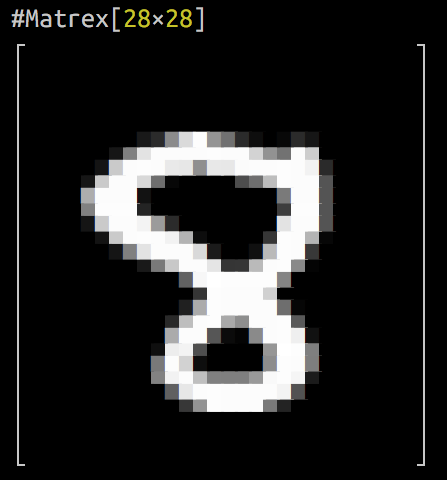
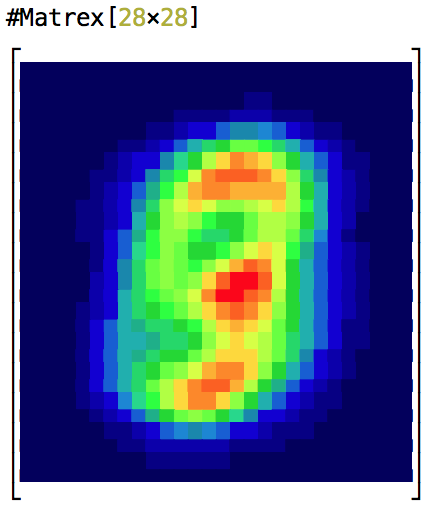
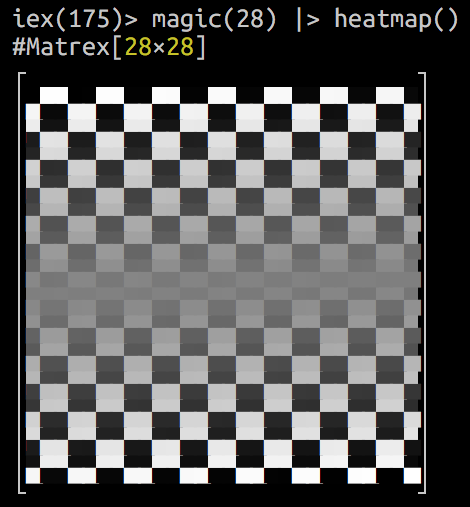
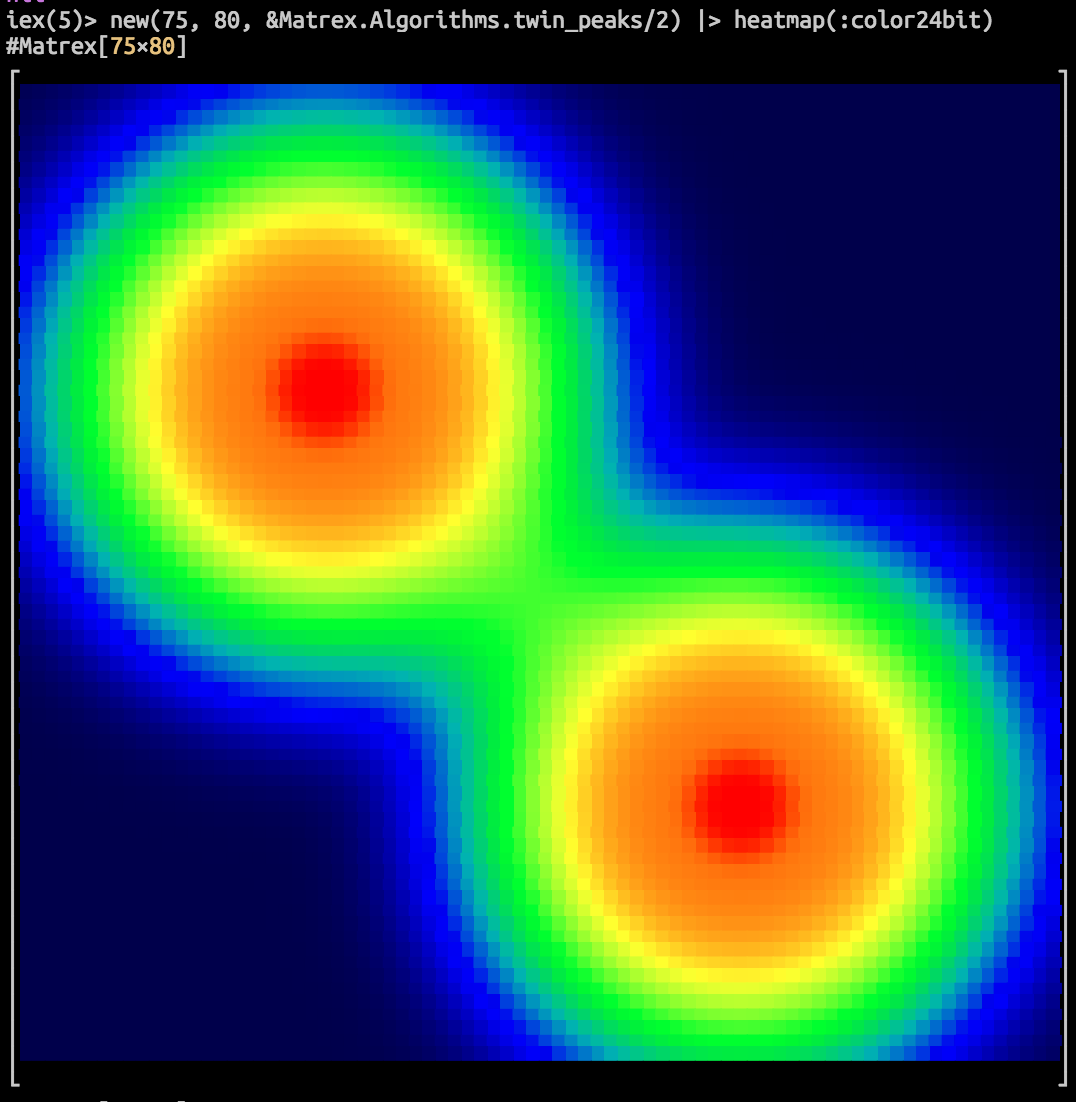
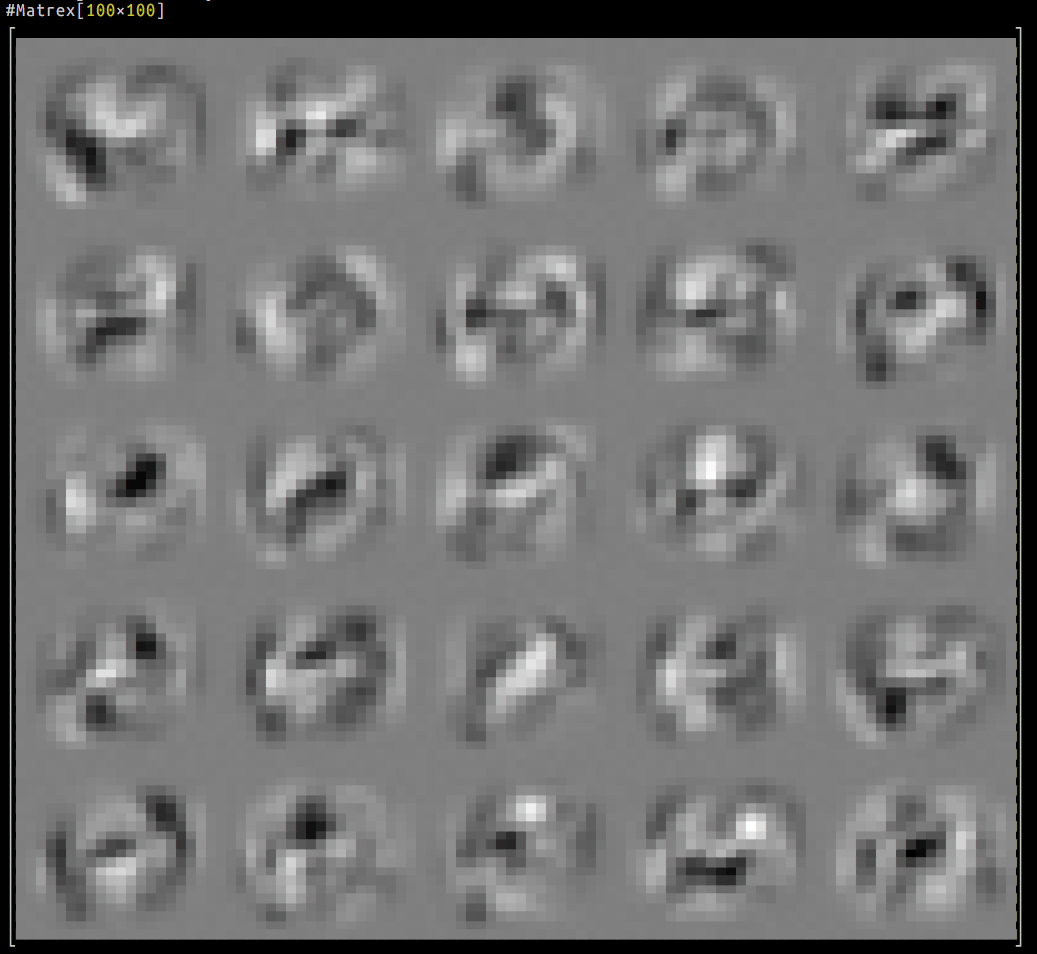
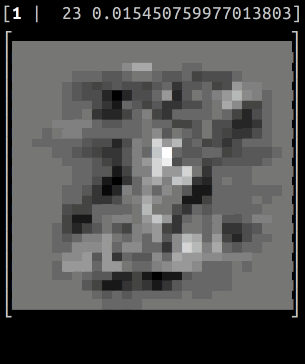
An alias for eye/1.
Returns list of all rows of a matrix as single-row matrices.
Example
iex> m = Matrex.reshape(1..6, 3, 2)
#Matrex[6×2]
┌ ┐
│ 1.0 2.0 │
│ 3.0 4.0 │
│ 5.0 6.0 │
└ ┘
iex> Matrex.list_of_rows(m)
[#Matrex[1×2]
┌ ┐
│ 1.0 2.0 │
└ ┘,
#Matrex[1×2]
┌ ┐
│ 3.0 4.0 │
└ ┘,
#Matrex[1×2]
┌ ┐
│ 5.0 6.0 │
└ ┘]Returns range of rows of a matrix as list of 1-row matrices.
Example
iex> m = Matrex.reshape(1..12, 6, 2)
#Matrex[6×2]
┌ ┐
│ 1.0 2.0 │
│ 3.0 4.0 │
│ 5.0 6.0 │
│ 7.0 8.0 │
│ 9.0 10.0 │
│ 11.0 12.0 │
└ ┘
iex> Matrex.list_of_rows(m, 2..4)
[#Matrex[1×2]
┌ ┐
│ 3.0 4.0 │
└ ┘,
#Matrex[1×2]
┌ ┐
│ 5.0 6.0 │
└ ┘,
#Matrex[1×2]
┌ ┐
│ 7.0 8.0 │
└ ┘]Load matrex from file.
.csv and .mtx (binary) formats are supported.
Example
iex> Matrex.load("test/matrex.csv")
#Matrex[5×4]
┌ ┐
│ 0.0 4.8e-4-0.00517-0.01552 │
│-0.01616-0.01622 -0.0161-0.00574 │
│ 6.8e-4 0.0 0.0 0.0 │
│ 0.0 0.0 0.0 0.0 │
│ 0.0 0.0 0.0 0.0 │
└ ┘Creates "magic" n*n matrix, where sums of all dimensions are equal.
Example
iex> Matrex.magic(5)
#Matrex[5×5]
┌ ┐
│ 16.0 23.0 5.0 7.0 14.0 │
│ 22.0 4.0 6.0 13.0 20.0 │
│ 3.0 10.0 12.0 19.0 21.0 │
│ 9.0 11.0 18.0 25.0 2.0 │
│ 15.0 17.0 24.0 1.0 8.0 │
└ ┘Maximum element in a matrix. NIF.
Example
iex> m = Matrex.magic(5)
#Matrex[5×5]
┌ ┐
│ 16.0 23.0 5.0 7.0 14.0 │
│ 22.0 4.0 6.0 13.0 20.0 │
│ 3.0 10.0 12.0 19.0 21.0 │
│ 9.0 11.0 18.0 25.0 2.0 │
│ 15.0 17.0 24.0 1.0 8.0 │
└ ┘
iex> Matrex.max(m)
25.0
iex> Matrex.reshape([1, 2, :inf, 4, 5, 6], 2, 3) |> max()
:infReturns maximum finite element of a matrex. NIF.
Used on matrices which may contain infinite values.
Example
iex>Matrex.reshape([1, 2, :inf, 3, :nan, 5], 3, 2) |> Matrex.max_finite()
5.0Minimum element in a matrix. NIF.
Example
iex> m = Matrex.magic(5)
#Matrex[5×5]
┌ ┐
│ 16.0 23.0 5.0 7.0 14.0 │
│ 22.0 4.0 6.0 13.0 20.0 │
│ 3.0 10.0 12.0 19.0 21.0 │
│ 9.0 11.0 18.0 25.0 2.0 │
│ 15.0 17.0 24.0 1.0 8.0 │
└ ┘
iex> Matrex.min(m)
1.0
iex> Matrex.reshape([1, 2, :neg_inf, 4, 5, 6], 2, 3) |> max()
:neg_infReturns minimum finite element of a matrex. NIF.
Used on matrices which may contain infinite values.
Example
iex>Matrex.reshape([1, 2, :neg_inf, 3, 4, 5], 3, 2) |> Matrex.min_finite()
1.0Elementwise multiplication of two matrices or matrix and a scalar. NIF.
Raises ErlangError if matrices' sizes do not match.
Examples
iex> Matrex.new([[1, 2, 3], [4, 5, 6]]) |>
...> Matrex.multiply(Matrex.new([[5, 2, 1], [3, 4, 6]]))
#Matrex[2×3]
┌ ┐
│ 5.0 4.0 3.0 │
│ 12.0 20.0 36.0 │
└ ┘
iex> Matrex.new([[1, 2, 3], [4, 5, 6]]) |> Matrex.multiply(2)
#Matrex[2×3]
┌ ┐
│ 2.0 4.0 6.0 │
│ 8.0 10.0 12.0 │
└ ┘Negates each element of the matrix. NIF.
Example
iex> Matrex.new([[1, 2, 3], [4, 5, 6]]) |> Matrex.neg()
#Matrex[2×3]
┌ ┐
│ -1.0 -2.0 -3.0 │
│ -4.0 -5.0 -6.0 │
└ ┘Creates new matrix from list of lists or text representation (compatible with MathLab/Octave).
List of lists can contain other matrices, which are concatenated in one.
Example
iex> Matrex.new([[1, 2, 3], [4, 5, 6]])
#Matrex[2×3]
┌ ┐
│ 1.0 2.0 3.0 │
│ 4.0 5.0 6.0 │
└ ┘
iex> Matrex.new([[Matrex.fill(2, 1.0), Matrex.fill(2, 3, 2.0)],
...> [Matrex.fill(1, 2, 3.0), Matrex.fill(1, 3, 4.0)]])
#Matrex[5×5]
┌ ┐
│ 1.0 1.0 2.0 2.0 2.0 │
│ 1.0 1.0 2.0 2.0 2.0 │
│ 3.0 3.0 4.0 4.0 4.0 │
└ ┘
iex> Matrex.new("1;0;1;0;1")
#Matrex[5×1]
┌ ┐
│ 1.0 │
│ 0.0 │
│ 1.0 │
│ 0.0 │
│ 1.0 │
└ ┘
iex> Matrex.new("""
...> 1.00000 0.10000 0.60000 1.10000
...> 1.00000 0.20000 0.70000 1.20000
...> 1.00000 NaN 0.80000 1.30000
...> Inf 0.40000 0.90000 1.40000
...> 1.00000 0.50000 NegInf 1.50000
...> """)
#Matrex[5×4]
┌ ┐
│ 1.0 0.1 0.6 1.1 │
│ 1.0 0.2 0.7 1.2 │
│ 1.0 NaN 0.8 1.3 │
│ ∞ 0.4 0.9 1.4 │
│ 1.0 0.5 -∞ 1.5 │
└ ┘Creates new matrix with values provided by the given function.
If function accepts two arguments one-based row and column index of each element are passed to it.
Examples
iex> Matrex.new(3, 3, fn -> :rand.uniform() end)
#Matrex[3×3]
┌ ┐
│ 0.45643 0.91533 0.25332 │
│ 0.29095 0.21241 0.9776 │
│ 0.42451 0.05422 0.92863 │
└ ┘
iex> Matrex.new(3, 3, fn row, col -> row*col end)
#Matrex[3×3]
┌ ┐
│ 1.0 2.0 3.0 │
│ 2.0 4.0 6.0 │
│ 3.0 6.0 9.0 │
└ ┘Bring all values of matrix into [0, 1] range. NIF.
Where 0 corresponds to the minimum value of the matrix, and 1 — to the maxixmim.
Example
iex> m = Matrex.reshape(1..9, 3, 3)
#Matrex[3×3]
┌ ┐
│ 1.0 2.0 3.0 │
│ 4.0 5.0 6.0 │
│ 7.0 8.0 9.0 │
└ ┘
iex> Matrex.normalize(m)
#Matrex[3×3]
┌ ┐
│ 0.0 0.125 0.25 │
│ 0.375 0.5 0.625 │
│ 0.75 0.875 1.0 │
└ ┘Create matrex of ones of square dimensions or consuming output of size/1 function.
Examples
iex> Matrex.ones(3)
#Matrex[3×3]
┌ ┐
│ 1.0 1.0 1.0 │
│ 1.0 1.0 1.0 │
│ 1.0 1.0 1.0 │
└ ┘
iex> m = Matrex.new("1 2 3; 4 5 6")
#Matrex[2×3]
┌ ┐
│ 1.0 2.0 3.0 │
│ 4.0 5.0 6.0 │
└ ┘
iex> Matrex.ones(Matrex.size(m))
#Matrex[2×3]
┌ ┐
│ 1.0 1.0 1.0 │
│ 1.0 1.0 1.0 │
└ ┘Create matrix filled with ones.
Example
iex> Matrex.ones(2, 3)
#Matrex[2×3]
┌ ┐
│ 1.0 1.0 1.0 │
│ 1.0 1.0 1.0 │
└ ┘Prints matrix to the console.
Accepted options:
:rows— number of rows of matrix to show. Defaults to 21:columns— number of columns of matrix to show. Defaults to maximum number of column, that fits into current terminal width.Returns the matrix itself, so can be used in pipes.
Example
iex> print(m, rows: 5, columns: 3) #Matrex[20×20] ┌ ┐ │ 1.0 399.0 … 20.0 │ │ 380.0 22.0 … 361.0 │ │ 360.0 42.0 … 341.0 │ │ ⋮ ⋮ … ⋮ │ │ 40.0 362.0 … 21.0 │ │ 381.0 19.0 … 400.0 │ └ ┘
Create square matrix of random floats.
See random/2 for details.
Example
iex> Matrex.random(3)
#Matrex[3×3]
┌ ┐
│ 0.66438 0.31026 0.98602 │
│ 0.82127 0.04701 0.13278 │
│ 0.96935 0.70772 0.98738 │
└ ┘Create matrix of random floats in [0, 1] range. NIF.
C language RNG is seeded on NIF libray load with srandom(time(NULL) + clock()).
Example
iex> Matrex.random(4,3)
#Matrex[4×3]
┌ ┐
│ 0.32994 0.28736 0.88012 │
│ 0.51782 0.68608 0.29976 │
│ 0.52953 0.9071 0.26743 │
│ 0.82189 0.59311 0.8451 │
└ ┘Reshapes list of values into a matrix of given size or changes the shape of existing matrix.
Takes a list or anything, that implements Enumerable.to_list/1.
Can take a list of matrices and concatenate them into one big matrix.
Raises ArgumentError if list size and given shape do not match.
Example
iex> [1, 2, 3, 4, 5, 6] |> Matrex.reshape(2, 3)
#Matrex[2×3]
┌ ┐
│ 1.0 2.0 3.0 │
│ 4.0 5.0 6.0 │
└ ┘
iex> Matrex.reshape([Matrex.zeros(2), Matrex.ones(2),
...> Matrex.fill(3, 2, 2.0), Matrex.fill(3, 2, 3.0)], 2, 2)
#Matrex[5×4]
┌ ┐
│ 0.0 0.0 1.0 1.0 │
│ 0.0 0.0 1.0 1.0 │
│ 2.0 2.0 3.0 3.0 │
│ 2.0 2.0 3.0 3.0 │
│ 2.0 2.0 3.0 3.0 │
└ ┘
iex> Matrex.reshape(1..6, 2, 3)
#Matrex[2×3]
┌ ┐
│ 1.0 2.0 3.0 │
│ 4.0 5.0 6.0 │
└ ┘
iex> Matrex.new("1 2 3; 4 5 6") |> Matrex.reshape(3, 2)
#Matrex[3×2]
┌ ┐
│ 1.0 2.0 │
│ 3.0 4.0 │
│ 5.0 6.0 │
└ ┘Resize matrix by scaling its dimenson with scale. NIF.
Examples
iex> m = Matrex.magic(3)
#Matrex[3×3]
┌ ┐
│ 8.0 1.0 6.0 │
│ 3.0 5.0 7.0 │
│ 4.0 9.0 2.0 │
└ ┘
iex(3)> Matrex.resize(m, 2)
#Matrex[6×6]
┌ ┐
│ 8.0 8.0 1.0 1.0 6.0 6.0 │
│ 8.0 8.0 1.0 1.0 6.0 6.0 │
│ 3.0 3.0 5.0 5.0 7.0 7.0 │
│ 3.0 3.0 5.0 5.0 7.0 7.0 │
│ 4.0 4.0 9.0 9.0 2.0 2.0 │
│ 4.0 4.0 9.0 9.0 2.0 2.0 │
└ ┘
iex(4)> m = Matrex.magic(5)
#Matrex[5×5]
┌ ┐
│ 16.0 23.0 5.0 7.0 14.0 │
│ 22.0 4.0 6.0 13.0 20.0 │
│ 3.0 10.0 12.0 19.0 21.0 │
│ 9.0 11.0 18.0 25.0 2.0 │
│ 15.0 17.0 24.0 1.0 8.0 │
└ ┘
iex(5)> Matrex.resize(m, 0.5)
#Matrex[3×3]
┌ ┐
│ 16.0 23.0 7.0 │
│ 22.0 4.0 13.0 │
│ 9.0 11.0 25.0 │
└ ┘Get row of matrix as matrix (vector) in matrex form. One-based.
You can use shorter matrex[n] syntax for the same result.
Example
iex> m = Matrex.magic(5)
#Matrex[5×5]
┌ ┐
│ 16.0 23.0 5.0 7.0 14.0 │
│ 22.0 4.0 6.0 13.0 20.0 │
│ 3.0 10.0 12.0 19.0 21.0 │
│ 9.0 11.0 18.0 25.0 2.0 │
│ 15.0 17.0 24.0 1.0 8.0 │
└ ┘
iex> Matrex.row(m, 4)
#Matrex[1×5]
┌ ┐
│ 9.0 11.0 18.0 25.0 2.0 │
└ ┘
iex> m[4]
#Matrex[1×5]
┌ ┐
│ 9.0 11.0 18.0 25.0 2.0 │
└ ┘Return matrix row as list by one-based index.
Example
iex> m = Matrex.magic(5)
#Matrex[5×5]
┌ ┐
│ 16.0 23.0 5.0 7.0 14.0 │
│ 22.0 4.0 6.0 13.0 20.0 │
│ 3.0 10.0 12.0 19.0 21.0 │
│ 9.0 11.0 18.0 25.0 2.0 │
│ 15.0 17.0 24.0 1.0 8.0 │
└ ┘
iex> Matrex.row_to_list(m, 3)
[3.0, 10.0, 12.0, 19.0, 21.0]Saves matrex into file.
Binary (.mtx) and CSV formats are supported currently.
Format is defined by the extension of the filename.
Example
iex> Matrex.random(5) |> Matrex.save("r.mtx")
:okTransfer one-element matrix to a scalar value.
Differently from first/1 will not match and throw an error,
if matrix contains more than one element.
Example
iex> Matrex.new([[1.234]]) |> Matrex.scalar()
1.234
iex> Matrex.new([[0]]) |> Matrex.divide(0) |> Matrex.scalar()
:nan
iex> Matrex.new([[1.234, 5.678]]) |> Matrex.scalar()
** (FunctionClauseError) no function clause matching in Matrex.scalar/1Set element of matrix at the specified position (one-based) to new value.
Example
iex> m = Matrex.ones(3)
#Matrex[3×3]
┌ ┐
│ 1.0 1.0 1.0 │
│ 1.0 1.0 1.0 │
│ 1.0 1.0 1.0 │
└ ┘
iex> m = Matrex.set(m, 2, 2, 0)
#Matrex[3×3]
┌ ┐
│ 1.0 1.0 1.0 │
│ 1.0 0.0 1.0 │
│ 1.0 1.0 1.0 │
└ ┘
iex> m = Matrex.set(m, 3, 2, :neg_inf)
#Matrex[3×3]
┌ ┐
│ 1.0 1.0 1.0 │
│ 1.0 0.0 1.0 │
│ 1.0 -∞ 1.0 │
└ ┘Set column of a matrix to the values from the given 1-column matrix. NIF.
Example
iex> m = Matrex.reshape(1..6, 3, 2)
#Matrex[3×2]
┌ ┐
│ 1.0 2.0 │
│ 3.0 4.0 │
│ 5.0 6.0 │
└ ┘
iex> Matrex.set_column(m, 2, Matrex.new("7; 8; 9"))
#Matrex[3×2]
┌ ┐
│ 1.0 7.0 │
│ 3.0 8.0 │
│ 5.0 9.0 │
└ ┘Return size of matrix as {rows, cols}
Example
iex> m = Matrex.random(2,3)
#Matrex[2×3]
┌ ┐
│ 0.69745 0.23668 0.36376 │
│ 0.63423 0.29651 0.22844 │
└ ┘
iex> Matrex.size(m)
{2, 3}Produces element-wise squared matrix. NIF through multiply/4.
Example
iex> m = Matrex.new("1 2 3; 4 5 6")
#Matrex[2×3]
┌ ┐
│ 1.0 2.0 3.0 │
│ 4.0 5.0 6.0 │
└ ┘
iex> Matrex.square(m)
#Matrex[2×3]
┌ ┐
│ 1.0 4.0 9.0 │
│ 16.0 25.0 36.0 │
└ ┘Returns submatrix for a given matrix. NIF.
Rows and columns ranges are inclusive and one-based.
Example
iex> m = Matrex.new("1 2 3; 4 5 6; 7 8 9")
#Matrex[3×3]
┌ ┐
│ 1.0 2.0 3.0 │
│ 4.0 5.0 6.0 │
│ 7.0 8.0 9.0 │
└ ┘
iex> Matrex.submatrix(m, 2..3, 2..3)
#Matrex[2×2]
┌ ┐
│ 5.0 6.0 │
│ 8.0 9.0 │
└ ┘Subtracts two matrices or matrix from scalar element-wise. NIF.
Raises ErlangError if matrices' sizes do not match.
Examples
iex> Matrex.new([[1, 2, 3], [4, 5, 6]]) |>
...> Matrex.subtract(Matrex.new([[5, 2, 1], [3, 4, 6]]))
#Matrex[2×3]
┌ ┐
│ -4.0 0.0 2.0 │
│ 1.0 1.0 0.0 │
└ ┘
iex> Matrex.subtract(1, Matrex.new([[1, 2, 3], [4, 5, 6]]))
#Matrex[2×3]
┌ ┐
│ 0.0 -1.0 -2.0 │
│ -3.0 -4.0 -5.0 │
└ ┘Subtracts the second matrix or scalar from the first. Inlined.
Raises ErlangError if matrices' sizes do not match.
Example
iex> Matrex.new([[1, 2, 3], [4, 5, 6]]) |>
...> Matrex.subtract_inverse(Matrex.new([[5, 2, 1], [3, 4, 6]]))
#Matrex[2×3]
┌ ┐
│ 4.0 0.0 -2.0 │
│ -1.0 -1.0 0.0 │
└ ┘
iex> Matrex.eye(3) |> Matrex.subtract_inverse(1)
#Matrex[3×3]
┌ ┐
│ 0.0 1.0 1.0 │
│ 1.0 0.0 1.0 │
│ 1.0 1.0 0.0 │
└ ┘Sums all elements. NIF.
Can return special float values as atoms.
Example
iex> m = Matrex.magic(3)
#Matrex[3×3]
┌ ┐
│ 8.0 1.0 6.0 │
│ 3.0 5.0 7.0 │
│ 4.0 9.0 2.0 │
└ ┘
iex> Matrex.sum(m)
45.0
iex> m = Matrex.new("1 Inf; 2 3")
#Matrex[2×2]
┌ ┐
│ 1.0 ∞ │
│ 2.0 3.0 │
└ ┘
iex> sum(m)
:infConvert any matrix m×n to a column matrix (m*n)×1.
Example
iex> m = Matrex.magic(3)
#Matrex[3×3]
┌ ┐
│ 8.0 1.0 6.0 │
│ 3.0 5.0 7.0 │
│ 4.0 9.0 2.0 │
└ ┘
iex> Matrex.to_column(m)
#Matrex[1×9]
┌ ┐
│ 8.0 1.0 6.0 3.0 5.0 7.0 4.0 9.0 2.0 │
└ ┘Converts to flat list. NIF.
Example
iex> m = Matrex.magic(3)
#Matrex[3×3]
┌ ┐
│ 8.0 1.0 6.0 │
│ 3.0 5.0 7.0 │
│ 4.0 9.0 2.0 │
└ ┘
iex> Matrex.to_list(m)
[8.0, 1.0, 6.0, 3.0, 5.0, 7.0, 4.0, 9.0, 2.0]Converts to list of lists. NIF.
Examples
iex> m = Matrex.magic(3)
#Matrex[3×3]
┌ ┐
│ 8.0 1.0 6.0 │
│ 3.0 5.0 7.0 │
│ 4.0 9.0 2.0 │
└ ┘
iex> Matrex.to_list_of_lists(m)
[[8.0, 1.0, 6.0], [3.0, 5.0, 7.0], [4.0, 9.0, 2.0]]
iex> r = Matrex.divide(Matrex.eye(3), Matrex.zeros(3))
#Matrex[3×3]
┌ ┐
│ ∞ NaN NaN │
│ NaN ∞ NaN │
│ NaN NaN ∞ │
└ ┘
iex> Matrex.to_list_of_lists(r)
[[:inf, :nan, :nan], [:nan, :inf, :nan], [:nan, :nan, :inf]]Convert any matrix m×n to a row matrix 1×(m*n).
Example
iex> m = Matrex.magic(3)
#Matrex[3×3]
┌ ┐
│ 8.0 1.0 6.0 │
│ 3.0 5.0 7.0 │
│ 4.0 9.0 2.0 │
└ ┘
iex> Matrex.to_row(m)
#Matrex[1×9]
┌ ┐
│ 8.0 1.0 6.0 3.0 5.0 7.0 4.0 9.0 2.0 │
└ ┘Trace of matrix (sum of all diagonal elements). Elixir.
Can return special float values as atoms.
Example
iex> m = Matrex.magic(3)
#Matrex[3×3]
┌ ┐
│ 8.0 1.0 6.0 │
│ 3.0 5.0 7.0 │
│ 4.0 9.0 2.0 │
└ ┘
iex> Matrex.trace(m)
15.0
iex> m = Matrex.new("Inf 1; 2 3")
#Matrex[2×2]
┌ ┐
│ ∞ 1.0 │
│ 2.0 3.0 │
└ ┘
iex> trace(m)
:infTransposes a matrix. NIF.
Example
iex> m = Matrex.new([[1,2,3],[4,5,6]])
#Matrex[2×3]
┌ ┐
│ 1.0 2.0 3.0 │
│ 4.0 5.0 6.0 │
└ ┘
iex> Matrex.transpose(m)
#Matrex[3×2]
┌ ┐
│ 1.0 4.0 │
│ 2.0 5.0 │
│ 3.0 6.0 │
└ ┘Updates the element at the given position in matrix with function.
Function is invoked with the current element value
Example
iex> m = Matrex.reshape(1..6, 3, 2)
#Matrex[3×2]
┌ ┐
│ 1.0 2.0 │
│ 3.0 4.0 │
│ 5.0 6.0 │
└ ┘
iex> Matrex.update(m, 2, 2, fn x -> x * x end)
#Matrex[3×2]
┌ ┐
│ 1.0 2.0 │
│ 3.0 16.0 │
│ 5.0 6.0 │
└ ┘Create square matrix of size size rows × size columns, filled with zeros. Inlined.
Example
iex> Matrex.zeros(3)
#Matrex[3×3]
┌ ┐
│ 0.0 0.0 0.0 │
│ 0.0 0.0 0.0 │
│ 0.0 0.0 0.0 │
└ ┘Create matrix of zeros of the specified size. NIF, using memset().
Faster, than fill(rows, cols, 0).
Example
iex> Matrex.zeros(4,3)
#Matrex[4×3]
┌ ┐
│ 0.0 0.0 0.0 │
│ 0.0 0.0 0.0 │
│ 0.0 0.0 0.0 │
│ 0.0 0.0 0.0 │
└ ┘